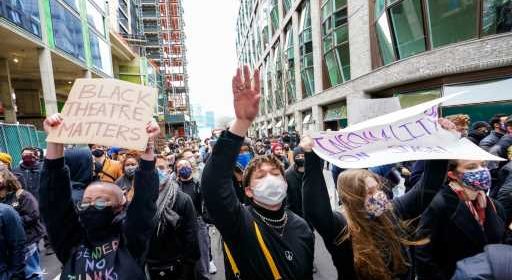New York Theater Remains Overwhelmingly White, Marginalized Communities “Vastly Underfunded”, Study Finds

A new study analyzing racial equity in arts funding in New York City finds that public and private contributions to the 18 largest and predominantly white non-profit theater companies garner 92% of total funding, a disparity the study suggests calls into question the industry’s oft-stated commitment to racial equity.
The study, called The Visibility Report and released by the Asian American Performers Action Coalition, examines the 2018-19 theater season, the last full season prior to the Covid-19 pandemic shutdown.
In a letter accompanying the study, AAPAC writes that “the story of the 2018-19 theatre season is one of an industry under pressure to diversify without a clear idea of how best to do it without fundamentally upsetting existing power structures.”
Determining that theater companies in marginalized communities were “vastly underfunded” in comparison to larger, White-led theater companies, the study finds that predominantly white institutions received nearly $150 million in total funding, while the theaters of color received roughly $12.5 million. Of $21 million that came from government funding alone, white institutions received four times more federal funding that BIPOC companies, and twice as much in state funding. Funding on the city level was deemed more equitable.
Watch on Deadline
The greatest disparity, according to the study, came from private foundations and individual donors, with theaters of color receiving just $7.5 million in private funding while the predominantly white institutions received $132.7 million.
The report tracks actors, playwrights, composers, librettists, lyricists, directors, artistic directors, designers, Broadway producers, general managers, and board members at the non-profit theatre companies. AAPAC says The Visibility Report is the only publicly available report of its kind.
Among the reports other findings:
- 100% of artistic directors at the largest non-profits were white. 88% of board members were white. On Broadway, 93.6% of the producers from the 18-19 season were white as were 100% of general managers;
- Broadway, AAPAC says, tried to diversify “without fundamentally changing its framework, increasing its use of inclusive casting by a giant 12% to 28.4% of all roles — a new record — yet the net gain for hiring of Black, Indigenous and People of Color (BIPOC) actors was only 0.5% higher than the previous year and most of the gains came in chorus roles.”
- White actors took 65.9%, or almost two-thirds of all available roles;
- White narratives were centered with white actors playing 80% of the lead roles in musicals and 89.7% of lead roles in plays;
- BIPOC writers “plummeted 9 points on Broadway this season to just 11%;
- Only one commercial production could be categorized as “a culturally-specific story” written by a BIPOC writer: Ain’t Too Proud: The Life and Times of The Temptations. Among Broadway nonprofits, the sole example was Manhattan Theatre Club’s Choir Boy. Both productions were directed by white directors;
- 93.8% of all directors on Broadway were white, similar to the year before, as were 92.6% of Broadway designers;
- Racially-specific stories with majority BIPOC casts in the nonprofit theater realm fared much better, increasing as a percentage of total output to more than 90% from 32.4% the prior season. Still, BIPOC writers increased just 3 points to 23.9%;
- The report calculated that for every $1 spent by nonprofits on white actors, only $0.71 cents was spent on BIPOC actors. Broken down by race, $0.53 was spent on Black actors, $0.10 on Asian American actors, $0.05 on Latinx actors, $0.02 on Middle East and North Africa actors and $0 on Indigenous actors.
The study reports that, though white actors continued “to overrepresent based on their population size in the NYC area, BIPOC actor representation increased 6% at the non-profits to approach 54.5% of all roles, a record high.” AAPAC attributes the increase largely to the efforts of seven theater companies that hired majority BIPOC actors for the season: The Atlantic Theater, MCC, New York Theatre Workshop, Playwrights Horizons, The Public Theater, Signature Theater, and The Vineyard Theatre.
Still, the report indicates, exclusion of marginalized writers remained “rampant,” with only one Latinx, one Middle East and North Africa and one Indigenous writer produced at the non-profits throughout the season.
The theater company listed as the most diverse of the year – Off Broadway’s The Public Theater – had one of the lowest percentages of any non-profit when it came to hiring Asian American actors, according to the study, with only 3.4% of all Public roles filled by Asian American actors.
“For a company that used inclusive casting to cast 42.1% of their roles, it betrays a glaring area of unconscious bias when Asian American actors only accounted for less than a percentage point.”
Black actors, according to the report, were the only group whose representation onstage increased, “jumping significantly from 23.2% to 29% in the 2018-2019 season.”
“While it is a positive indication that the industry seems to be placing more value on Black representation this season than in years past, it is also alarming that all other BIPOC numbers tumbled,” AAPAC writes. “It’s as if the industry could not hold more than one aspect of diversity at a time, especially if doing so would threaten the perceived primacy of White stories and White bodies on stage.”
Read the entire report here.
Read More About:
Source: Read Full Article
